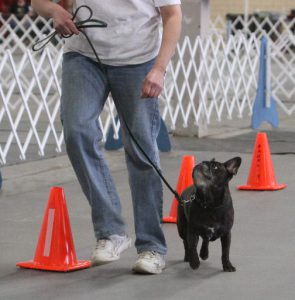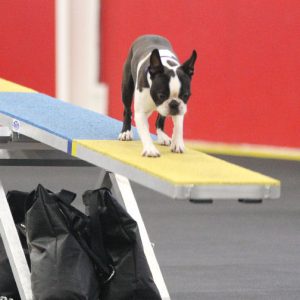All dogs can compete in dog sports – any size, breed, mixed breed. All dogs are welcome. Although all require some training to be successful – and to compete safely.
Rally and Agility are more active, fun-to-watch dog “sports.
Rally Trials go with Obedience Trials, but Rally is the faster, louder, little sibling of Obedience.
A couple similarities between Rally and Agility – both have a set “course” the dog/handler team must follow. Both allow the “handlers” (people part of the team) to “walk the course” before competing. Both are timed. Both allow you to talk to your dog while competing. Both are fun!
Rally Obedience
Getting involved in Rally is probably the easiest transition into dog sports. At the first level of competition (Novice), everything the dog has to do are variations of the regular “sit, down, stay, heel” commands. The Rally Novice course is performed entirely on-leash and there are only between 10 and 15 signs, or behaviors, that the team needs to complete.
Rally courses are laid out so they’re easy to follow. The signs are always on the person’t right-hand side, and they have instructions like “Turn Left” or “Halt. Walk around dog.”
Once you’ve seen a couple of teams go through the course, you’ll start to know the pattern of the course and know better how the team is doing, if they’ve completed the signs correctly, and begin to truly enjoy the teamwork and fun of it.
As you progress through the levels of Rally (Intermediate, Advanced, Excellent, and Masters), the behaviors on the signs get increasingly difficult, the dogs compete off-leash, and the wonderful teamwork of the experienced competitors and their dogs truly begins to shine. It takes quite a bit of training to do side-by-side spins with your dog!
Agility
Agility is the running, jumping, climbing, obstacle-course-racing part of dog sports.
Agility is the one that may look like it’s just an all-out race, and in some aspects, it is! The trick to agility isn’t to get your dog to run – all dogs can run. Or jump – most dogs can jump. It’s to do all the “stuff” in the right order at the fastest possible speed.
Most of the obstacles involved in agility are jumps. There are also tunnels a few yards long, the “dog walk” which is a one-foot-wide board four feet off the ground, weave poles (12 for the upper levels, six for Novice dogs), a seesaw, an A-Frame that towers over five feet tall, and the “Pause table” – which brings the run to a complete halt for five seconds. It shows that the chaos of the agility course truly is under control.
Every trial features a different course, created by the judge, that has the obstacles in a different order in different patterns. There are rules the judge has to follow in creating courses, like the distance between obstacles, what order they can be in, etc. The obstacles are numbered. Competitors “walk the course” for eight minutes before their competition class begins.
Agility is also the sport where it’s most important to find a good instructor – it can be dangerous for the dogs if done incorrectly. And for the people.
Everybody (and their dogs!) can do it!
Everyone who wants to find a place to play with their dogs can find dog sports to suit. Find more information about all our favorites on the American Kennel Club website.
Explore them, find out which one(s) you enjoy, get out there and have fun with your dog. You’ll meet some of the best people in the world – dog people!

















I came across your blog post explaining rally and agility dog sports, and I wanted to express my appreciation for the informative and well-written article. Your explanations of these two popular dog sports are concise and easy to understand, making it accessible for dog enthusiasts who may be new to these activities.
Your description of rally obedience provides a clear understanding of the sport. Rally combines elements of traditional obedience with a twist of fun and teamwork. The emphasis on positive reinforcement and the ability to interact with the dog during the course make rally a great option for dog owners who want to strengthen their bond with their canine companions while showcasing their obedience skills. I particularly liked how you highlighted the importance of clear communication between the handler and the dog, as it is a crucial element in successful rally performances.
Moving on to agility, you did an excellent job of explaining the sport and its various components. Agility is an exciting and fast-paced activity that requires dogs to navigate obstacles such as jumps, tunnels, weave poles, and more. Your explanation of the different classes and levels within agility competitions helps readers understand how dogs progress and challenge themselves as they gain experience. Additionally, your mention of the physical and mental benefits of agility for dogs is a valuable point. It’s important to note that while agility is a competitive sport, the emphasis on fun and teamwork between the handler and the dog remains a central aspect.
I also appreciate your mention of the training aspect and the importance of positive reinforcement techniques in both rally and agility. These sports provide opportunities for dogs to engage in mentally stimulating activities while strengthening their obedience and physical abilities. The focus on reward-based training methods not only enhances the learning experience for the dog but also helps build a trusting and positive relationship between the handler and their furry companion.
Your article serves as a great introduction to rally and agility, providing readers with a solid understanding of these two dog sports. It may even inspire dog owners to explore these activities with their own pets. By shedding light on the enjoyable and rewarding aspects of rally and agility, you’ve contributed to promoting these sports and encouraging more people to engage in interactive and fulfilling experiences with their dogs.
Thank you for sharing your knowledge and insights on rally and agility in such a concise and informative manner. Your article is a valuable resource for anyone interested in learning about these exciting dog sports.
Thanks so much! Glad you enjoyed the post and hope you’ll get out there and have some fun with your dog!